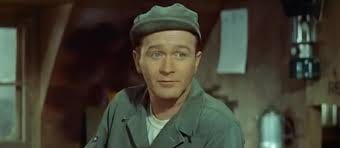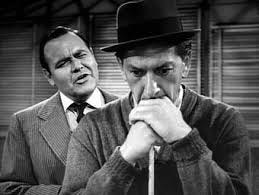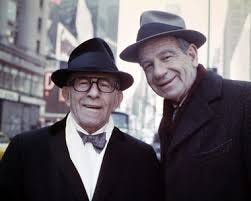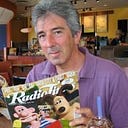No Laughs, Please: Our Greatest comedians as Dramatic Actors
“Dying is easy. Comedy is hard.”
This timeless quote has been most often attributed to 19th Century British actor Edmund Kean, who supposedly uttered it on his deathbed (although Larry Gelbart insisted the actor in question was Edmund Gwen, of Miracle on 34th Street fame). Regardless of who actually said it, our finest and funniest comedy legends of the past hundred years or so have been of the same opinion; that few dramatic actors through the years have been able to handle comedy believably, but most comedians can give a convincing, even award-winning dramatic performance when called upon to do so.

In his 1959 memoir Groucho and Me, Groucho Marx wrote, “There is hardly a comedian alive who isn’t capable of doing a first-rate dramatic role. But there are mighty few dramatic actors who could essay a comic role with any distinction…All first-rate comedians who have played dramatic roles are almost unanimous in saying that compared to being funny, dramatic acting is like a two-week vacation in the country.”

Most of the best comedians to succeed in dramatic roles first had to learn how to act in comedy, whether their “acting” was obvious to the audience or not. The great comedy producer Hal Roach, who gave the world the Our Gang (Little Rascals) series, as well as the team of Laurel & Hardy, maintained that “The great comedians imitate children. To be a great comedian you have to be a great actor, and to be a great actor you have to portray something. There is not a great visual actor that I know whose every movement is not that of a child…When you take a grown person, and do the same thing as you would do with a child, it becomes just as amusing. And that is the basis of so-called slapstick comedy.”
While not every comedian has the inherent skills necessary to give a convincing dramatic performance, the list of those who have succeeded is rather impressive, and even includes a few surprises.
Charlie Chaplin, hailed as one of the greatest of all film comedians, was also one of the earliest movie pioneers to use elements of drama or pathos in his comedy films; his more famous examples being The Kid which has his Little Tramp character taking in a young orphan (Jackie Coogan) to keep him from life in the orphanage, and City Lights, in which he befriends a blind flower girl. Upon recovering her eyesight after surgery, she recognizes him on the street, and sees him for who he really is — a tramp. He is overjoyed at her recovery, but we the audience can see in his face his sinking heart. This closing shot is considered one of the most heartbreaking in movie history.

Chaplin knew the arrival of sound films was a death knell for his famous character. But others who learned the comedy trade in silent went on to stardom in talkies. One shining example is Carole Lombard, who began her film career taking pies in the face for Mack Sennett’s silent comedies. She later grew into a superbly talented and elegant dramatic and comedic actress. By embracing slapstick, rather than relying on her naturally striking beauty, she was able to alternate between screwball comedies (My Man Godfrey, Nothing Sacred) and melodramas with remarkable ease, as few actresses have done since.

The post-war years brought on the Television Age, as well as comedians who dared to take on dramas on both television and film. Red Buttons, an established burlesque comedian who gained a national following with his own TV show in 1952, surprised many by winning the Oscar for Best Supporting Actor for his performance in Sayonara in 1954. He played a post-World War II airman in love with, and determined to marry, a Japanese woman despite warning from his superior (Marlon Brando). Buttons also made a fine dramatic contribution to the disaster epic The Poseidon Adventure, and, in his later years, his acting earned him an Emmy for a memorable guest role on ER. Comedian Shelley Berman said of Buttons, “I could name just a few [comedians as good actors], and whenever I am asked to name them, I have named Jackie Gleason, as an actor; I remember Jack Benny being a beautiful actor, and the other beautiful actor who’s a comedian is Red Buttons.”

Ed Wynn had already achieved legendary status as “The Perfect Fool” on stage and radio, regarded as a comedy master by his peers, almost thirty years before taking on dramatic roles in the late 1950s. In 1956, after a painstaking rehearsal process, he received an Emmy nomination for his role as Army in Rod Serling’s live TV classic Requiem for a Heavyweight. Serling later cast Wynn in two episodes of The Twilight Zone. Wynn continued to find work in other dramatic roles on television but also appeared in the film version of The Diary of Anne Frank, for which he received an Oscar nomination for his role as Mr. Dussell. “When he had a chance to do it,” Red Buttons said, “Ed Wynn was a wonderful, wonderful actor in the twilight of his career.”


Groucho Marx considered it an honor to be given the opportunity to act in Gilbert and Sullivan’s “The Mikado” on The Bell Telephone Hour in April of 1960. He played Ko-Ko the Lord High Executioner. “There were greater talents around to perform the operetta,” Groucho wrote, “but certainly no bigger Gilbert and Sullivan fan than myself.”
Milton Berle and Jackie Gleason, two of television’s comedy pioneers, also found success in dramatic roles. In 1961, Gleason co-starred with Mickey Rooney and Anthony Quinn in the film version of Requiem for a Heavyweight. Gleason gave an intense performance as Maish, the downtrodden, debt-ridden boxing manager. That same year, he played Minnesota Fats in The Hustler, starring Paul Newman. Gleason’s portrayal won him an Academy Award nomination. “I knew that I liked dramatic work,” he said in a 1984 interview for 60 Minutes, “and I was fortunate enough to be successful at it. I was between two heavyweights, Paul Newman and George C. Scott. And they’re awful good. And if you don’t want to look like a wimp, you’d better wind up and throw a couple. So you had to act in self-defense.”

The following year, Gleason also created and played the title character in the film Gigot — a poor, shabby, deaf-mute living in Paris. Gleason and the film (directed by Gene Kelly) were both lauded and panned for the unrelenting sentimentality permeating the story. Comedy director Garry Marshall said of him, “Jackie Gleason was mostly known as a comedian from TV but he was also a heck of an actor and did some wonderful work in films, and probably did not receive enough accolades as an actor.”

As for Berle, forever known as “Mr. Television,” and who almost single handedly jump- started television’s mass popularity with his variety show in 1948, took the plunge into drama and received an Emmy nomination for his role in “Doyle Against the House,” an installment of The Dick Powell Theater, televised in October of 1961. “In a straight role,” he explained, “there’s no going after laughs, no pauses or waiting — ‘if this is supposed to be funny shall I take three beats?’ It is much more difficult to be funny and to get laughs…” Jackie Gleason lauded Berle’s acting, saying “I have known many comedians — Berle is one — who were superb in serious drama, but there are very few serious actors who do comedy well.”

Berle made numerous appearances in TV dramas throughout the 1970s and ’80s, and, in January of 1995, appeared in an unlikely program, the youth-oriented Beverly Hills, 90210, as a nursing home patient suffering from Alzheimer’s. Berle sensitively portrayed a frightened man unable to maintain a firm command of his lucid moments. He received another Emmy nomination for the part.

Jonathan Winters’ comic improvisations on stage and television, beginning in the late ’50s, won him praise from audiences as well as his peers. He made his best-know dramatic role appear virtually effortless in an episode of The Twilight Zone titled “A Game of Pool.” In it, he played a deceased local pool-playing legend sent back to Earth to teach a young hotshot player (Jack Klugman) some humility. “A lot of people who’ve seen me do a couple of dramatic things come up to me and say, ‘I didn’t know you could act — I thought you only made noises.’ They forget that all of us can act; what else are we doing up there?”

Carol Burnett’s long-running comedy/variety series was going strong in 1974 when she turned in an Emmy-nominated dramatic performance in the true-life TV film Friendly Fire, in which she plays Peg Mullen, the mother of a son killed in Vietnam by friendly artillery fire, but saw a cover-up put in place regarding the circumstances of the accident. Ned Beatty played her husband Gene. The New York Times review praised the leads for playing their roles “superbly, with both compassion and painful honesty.” Burnett herself once said, “I have seen comedians switch over to drama with greater success than I have seen straight actors switch to comedy. Straight actors who aren’t really comedic force something too much.”

Burnett’s longtime friend, Dick Van Dyke, will be forever associated with his classic sitcom The Dick Van Dyke Show, and several beloved Disney musical comedies. As a recovering alcoholic in real life, however, he tackled the issue of alcoholism head-on in the 1974 TV drama The Morning After, in which he portrayed a successful man in denial of his drinking problem, until his world begins to unravel. That same year, he played a cold-hearted murderer on the Columbo episode “Negative Reaction.” In the 1990s, he found still more success with his series Diagnosis Murder.

Even legend George Burns, who appeared in a number of film comedies with his wife Gracie Allen in the 1930s, found his film career reinvigorated as he approached his 80th birthday. Granted, he wasn’t called upon to try his acting chops in a serious drama, but he played opposite Walter Matthau in Neil Simon’s The Sunshine Boys (a role originally intended for his late dear friend, Jack Benny), and won the 1975 Academy Award for Best Supporting Actor for his efforts. When asked at the time to evaluate his own acting abilities, he replied, “Good acting is when Walter Matthau says to me, ‘How are you?’ and if I answer ‘Fine,’ that’s good acting. If Walter Matthau asks me ‘How are you?’ and I answer ‘I think it fell on the floor,’ then that’s bad acting.” His Oscar win led to starring roles in comedies including Oh, God! and Going In Style.
Britain has also produced countless comic geniuses in the past century, but one, Peter Sellers, stands above all others as a comedy actor, having starred in a number of films, including Dr. Strangelove, in which he played multiple characters. Perhaps he’s best remembered as Inspector Clouseau in Blake Edwards’ Pink Panther films. However, Sellers turned in a remarkably subtle and quietly magnetic performance as Chance, in the 1979 film Being There, co-starring Shirley MacLaine and Melvyn Douglas. Sellers read the book, by Jerzy Kozinski, in 1972, and in the intervening years campaigned to play the main character, Chance; a quiet, simple-minded gardener whose knowledge of the world comes solely from what he’s seen on television. In the story, powerful millionaire Douglas and his wife MacLaine befriend him and somehow mistake his inane statements for brilliant insights. Soon even the President (Jack Warden) and TV talk show hosts fall under Chance’s spell as they hang on his every word.

This was Seller’s next-to last and certainly his finest among many of his brilliant film performances. It is one of incredible restraint; he speaks just above a whisper (with an American accent) and confines his physical movements to slow, deliberate gestures. But Sellers revealed later that, the day before shooting began, he panicked about how to play the role. He said to his wife, “I’ve had this thing for six years and, you know, I don’t know how I’m going to play Chance. I thought I knew everything about him, how he spoke, how he walked, acted, thought, but I realize now that I have to go and do it tomorrow, and I really don’t know.” Sellers figured it out soon enough; this role earned him his only Oscar nomination.

Even Monty Python co-founder Michael Palin has done fine work in dramatic roles, most memorably in Terry Gilliam’s 1985 masterpiece “Brazil,” in which Palin plays the cheerful yet vaguely sinister friend of bureaucrat Sam Lowry, played by Jonathan Pryce.
As for other American comedians taking on dramatic roles, Steve Martin is an example of a “wild and crazy guy” who first gained adulation among comedy fans as a stand-up, and who indulged in slapstick in his early films (The Jerk, All Of Me), but who later made a conscious decision to take his career in a different direction, as that of a character actor. His films of the late 1980s and ’90s (Father of the Bride, L.A. Story, Planes, Trains and Automobiles)toned down the heavily slapstick aspects of his performances, giving him opportunities to portray more fully developed characters who weren’t simply idiots. In the 2000s, however, he cranked up the comedy content again — however, Martin became lazy, making a string of inferior remakes of familiar classics (Roxanne, The Out of Towners, Sgt. Bilko, The Pink Panther) that never needed to be remade at all.
Jerry Lewis is a comedian who suffered the slings and arrows of his critics almost perpetually throughout his solo film and television career in the late 1950s and throughout the ’60s (with the sole exception of his best creation, The Nutty Professor). Only late in life — indeed as he entered his nineties — did his comic genius receive proper appreciation, especially from his fellow comedians. But he did earn praise for his dramatic performance in the 1983 film The King of Comedy, opposite Robert De Niro.

As Jerry Langford, Lewis plays a late-night talk show host, stalked and then kidnapped by social misfit Rupert Pupkin (De Niro) obsessed with performing his stand-up comedy routine on Langford’s show. Lewis plays it straight, giving an utterly believable, restrained performance, like nothing he had done before (or since). He said decades earlier, referring to Groucho’s observation, that “the hard job is doing comedy. That’s what’s rough. Acting is a snap, but acting for an actor is hard work…because that’s all he does. It is like two weeks in the country. Christ, that’s a pleasure, and easy…that’s nowhere as naked as being a comedian.”
Robin Williams shot to stardom as a manic, improvisational stand-up, then as the star of the TV hit Mork and Mindy, before revealing his talent for delivering strong dramatic performances. He took on a number of film comedies, from Popeye to The Birdcage, but then turned to fairly weighty dramas, such as Dead Poets Society, and Good Will Hunting, the latter for which he won his 1998 Oscar for Best Supporting Actor.
Bill Murray had the unenviable task of replacing Chevy Chase in the middle of Saturday Night Live’s second season, and struggled to establish his own comedy reputation on the show. He expanded upon his stint on SNL with film comedy hits including Ghostbusters and Caddyshack. His acting talents showed greater promise with Groundhog Day, and later, in Trainspotting, for which he was nominated for an Oscar. “It may sound funny,” he once said, “but [dramatic roles] are fun. They’re important, because they let people see another side of you. I think comedy’s a little harder. To play comedy, you have to be able to play straight. The way you modulate it and deliver it is what makes it become funny — but you have to be able to play straight.”

Coming full circle, let’s give silent comedy legend Roscoe “Fatty” Arbuckle the last word, from over a century ago, on the matter of performing drama vs. comedy. “Sometimes I think I’ve picked out the worst job in sight,” he said. “If you don’t believe me, try to be funny for thirty solid minutes yourself. After that, you’ll want to be a villain or a vampire just by way of a little relaxation.”
Until next time…
Until next time…
If you enjoyed this article, please click the “follow” button and follow me on Medium (no charge) for more articles on popular culture, music, films, television, entertainment history, and just plain old history.
You can also become a member in the Medium Partner Program to help support my writing. https://garryberman.medium.com/membership
Please visit my website, www.GarryBerman.com to read descriptions and reviews of my books (including The Funniest Decade: A Celebration of American Comedy in the 1930s), and order titles using the provided links to Amazon.com.
